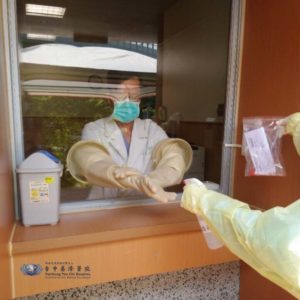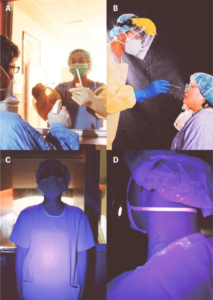An acrylic window built and installed in three days for $700 US dollars could be the answer to Personal Protective Equipment (PPE) supply woes in hospitals during COVID-19 and beyond.
The sealed barrier features a pair of rubber gloves, allowing health care workers to safely perform countless nasal swab tests with less PPE as recommended by the WHO.
PhD candidate Connie Gan from the Centre for Environment and Population Health (CEPH) leads qualitative research into implementing the use of the medical device in hospitals.
Designed by Drs Yu-Chi Tseng and Kai-Chen Tseng, the window works without an independent negative pressure room and the sampling station can be bolted into existing emergency departments dealing with the need to rapidly test for COVID-19.
Ms Gan is an Advisory Member at the Taichung Tzu Chi Hospital and collaborated with study co-author Dr Kuan-I Lee to be the first hospital in Taiwan to test the medical device.
The design specifications were published in the American Journal of Emergency Medicine.
 “The specimen collection process involves two people, a clinician performing the test behind the barrier and a second clinician outside the exam room,’’ Ms Gan said.
“The specimen collection process involves two people, a clinician performing the test behind the barrier and a second clinician outside the exam room,’’ Ms Gan said.
The second clinician wears the WHO recommended PPE and checks the fixed gloves regularly. They also deliver the sample for testing and disinfect all surfaces between patients.
Trials within the Taichung Tzu Chi Hospital reveal the gloves only needed replacing every two weeks and drastically reduced PPE waste.
“We wanted to address the supply shortage in PPE by changing the environment and reduce the stress and burden on health care workers with the current focus of reusing and extending the life of disposable PPE,” Ms Gan said.
“We wanted to address the supply shortage in PPE by changing the environment and reduce the stress and burden on health care workers with the current focus of reusing and extending the life of disposable PPE.”
Better, sustainable protection for the ‘age of pandemics’
The research team will soon co-publish the results of their study comparing the effectiveness of the barrier against a clinician conducting face-to-face swabbing in full WHO PPE in the Annals of Emergency Medicine.
During their test, they sprayed each clinician with a fluorescent agent to mimic the droplets of a real patient, checking results under a blacklight. The person behind the barrier was unaffected but the person in PPE, even when using a face shield, had droplets settle on their neck.
According to Ms Gan, the barrier also had a positive effect on health care workers and patients.
“Reusing disposable PPE puts a psychological burden on healthcare workers. We’re making it safer and easier to adapt to mass events with this design. Even patients think this looks safer.”
Ms Gan said the design also comprehensively addresses sustainability and waste management.
“We want to recommend this device in new and existing hospital settings as a permanent feature of emergency departments to deal with living in an age of pandemics. We’re seeing similar products appearing in the Philippines, Singapore, Thailand, Bangladesh and the US.”


